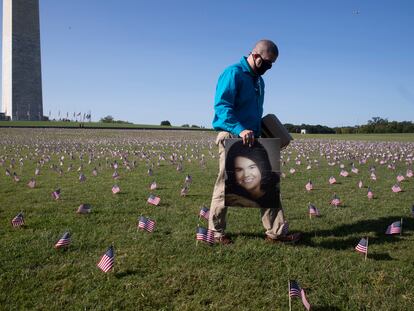Critical race theory and the 2020 US election
In 2016, Donald Trump fought against immigrants; now he attacks the Black Lives Matter movement – both campaigns are linked by white nationalism
What can we learn about the guiding philosophy of the Trump administration now that we have witnessed two campaigns? And do those campaigns teach us a lesson about the country that elected him? Trump’s 2016 campaign placed near-obsessive attention on immigration and the borders. His 2020 campaign has centered on racial unrest. How can we understand what appears to be a pivot away from a successful strategy? The answer lies in recognizing what ties together the two campaigns, as well as the intervening years. That link is white nationalism, the view that the United States is fundamentally a nation defined by the numerical and social dominance of its white population. The white nationalism that animated Trump’s 2016 campaign was described as a battle to secure the borders from invading immigrants. Now the same vitriol is being turned on American citizens.
In 2016, Donald Trump announced his presidency with a xenophobic rant. He began by vilifying China, and then, in that startling campaign introduction, famously said: “When Mexico sends its people, they’re not sending their best […] They’re sending people that have lots of problems [...] They’re bringing drugs. They’re bringing crime. They’re rapists. And some, I assume, are good people.”
Trump’s white nationalism is no less toxic than Nixon’s, and to his sizable base, it is a crucial part of his appeal as a candidate
Xenophobia cloaked in the language of law and order was central to his subsequent campaign. It was subsequently the overarching organizational principle of the first years of his administration.
Since taking office, Trump has orchestrated an effective end to asylum claims at the southern border that is in stark violation of international law, historic reductions to the cap set on refugee admissions and the reimposition of indiscriminately abusive enforcement practices against undocumented immigrants. While Trump failed to build any kind of physical wall, he has succeeded in virtually sealing the US border. To accomplish this, he enlisted US immigration enforcement agencies with a long history of violence and legally exceptional behavior, in what he has presented as a “law and order” campaign against immigrants, whom he and his administration have misleadingly associated with criminal gangs. Trump has also led an effort to close off lawful immigration and the legal entry of temporary workers, putting the lie to oft-stated claims that he represents people who are just opposed to undocumented immigration.
Scholars such as Maureen Craig and Jennifer Richeson have provided strong evidence for the pull of nativism in the US context in which the 2016 campaign was waged. Given that nativism was arguably the key to Trump’s success in 2016, it is surprising that immigration has not figured as prominently in Trump’s 2020 campaign strategy. Although the Trump administration has continued its immigration crackdown through the campaign season, Trump himself doesn’t speak about immigration with the obsessive focus that he did in 2016. What happened?
In the wake of the police killing of George Floyd in late May, the Black Lives Matter movement inspired nationwide protests across the United States against brutality towards Black Americans. Trump responded by endorsing counterprotests and authorizing unprecedented use of his Department of Homeland Security. As he did in his campaign against immigration, Trump cloaks these crackdowns on Black Lives Matter protesters in the language of “law and order.” Here, he takes a familiar page from Nixon’s successful “Law and Order” campaign of 1968, in the face of similar protests opposing police brutality towards Black Americans. Nixon was explicit about his racist motivations, as has been well documented, most recently by the historian Elizabeth Hinton. Trump’s white nationalism is no less toxic than Nixon’s, and to his sizable base, it is a crucial part of his appeal as a candidate.
Trump is now delivering to his followers the next phase of his war, in which his targets are the US citizens who have long been forced to the margins of their own country
Trump has also given somewhat improbable attention, during his campaign, to Critical Race Theory, particularly the efforts of scholars to center anti-Black racism in America’s understanding of itself. On September 22, Trump announced an executive order banning race, gender and sexual orientation sensitivity training in any institutions receiving federal funding. The Order explicitly forbids calling the United States fundamentally racist or sexist, as well as other forms of “inculcation,” as the Order’s language suggestively characterizes programs designed to raise awareness of unconscious bias and overt discrimination. It also apparently renders off-limits the teaching of histories of sexism, racism, as well as discrimination based on sexual orientation.
Apparently, Trump had been triggered by a widely-read New York Times series, the 1619 Project, an attempt to recenter American history around the consequences of slavery to the American project. Trump’s 2020 campaign has added the 1619 Project to its targets as well, with Trump promising to cut off federal funding for school districts that use it. Summarizing these lines of attack at an unprecedented “White House conference on American History” in September, Trump declared: “Critical race theory, the 1619 Project, and the crusade against American history is toxic propaganda, ideological poison that, if not removed, will dissolve the civic bonds that tie us together. It will destroy our country.” In the same speech, Trump also announced: “a national commission to promote patriotic education.”
Trump’s promotion of “patriotic education” squarely fits into a long history of teaching the American legacy of racism. The final chapter of W.E.B. Du Bois' magisterial 1935 work, Black Reconstruction, is entitled “The Propaganda of History.” In it, Du Bois denounces attempts to submerge truth behind narratives that seek to absolve the United States of its historical sins (which include indigenous genocide, as well as slavery and Jim Crow). The Trump campaign is fulfilling its promise to “Make America Great Again” by returning the country to the “propaganda of history” condemned by Du Bois almost a century ago, a history that masks the centrality of anti-Black racism and slavery to US history.
How can we make sense of Trump’s decision not to campaign on the anti-immigrant measures that have been his most successful set of policies? For the people at whom his messages are pitched, a sealed border was only the first stage of a longer process. With immigration halted and immigrants who remain forced to live in terror, Trump is now delivering to his followers the next phase of his war, in which his targets are the US citizens who have long been forced to the margins of their own country. Both the 2016 campaign and the 2020 campaign are celebrations of white nationalism. Both campaigns were about race all along.
The Trump administration’s attempt to banish Critical Race Theory is itself evidence of the power it has to unmask white nationalism. Trump’s presidential campaigns undergird a central claim of Critical Race Theory; America’s story has always been a story about race.
Elizabeth F. Cohen is a professor of political science at Syracuse University and is a Rockefeller Visiting Fellow at Princeton University’s Center for Human Values.
Jason Stanley is the Jacob Urowsky Professor of Philosophy at Yale University. He is the author of several books including How Fascism Works: The Politics of Us and Them (Random House).









































